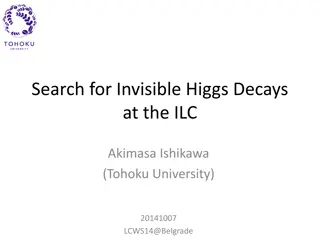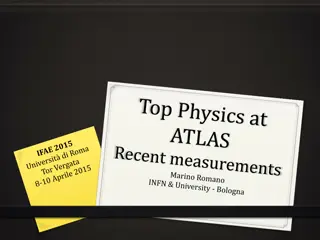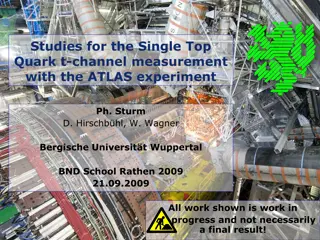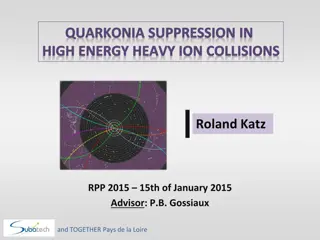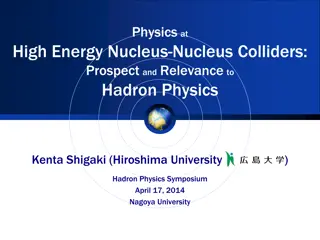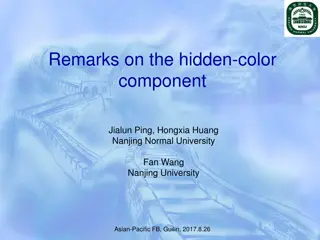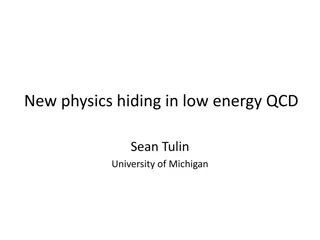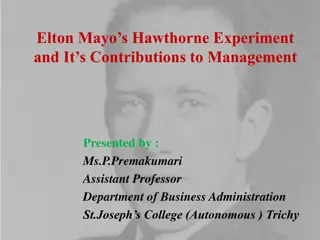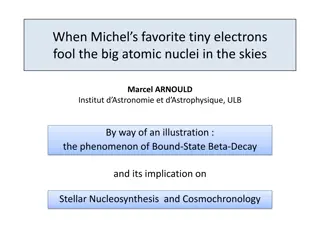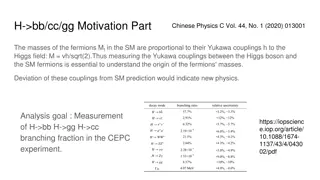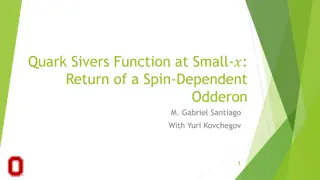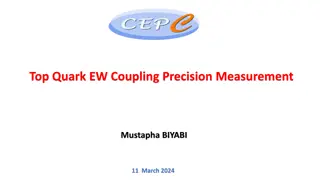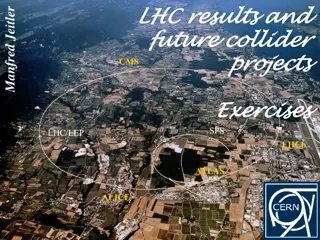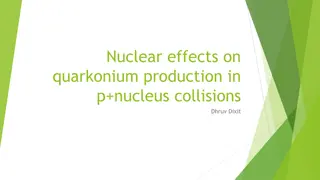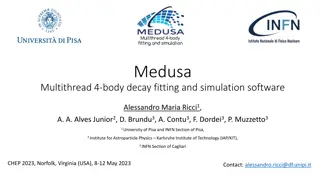Exploring Stop Quark Decays in High-Energy Physics Experiment
In this study, we delve into the analysis of Stop quark decays in the final state with 2 leptons, focusing on the soft single lepton and dilepton channels. The CMS experiment at 8 TeV energy level explores 4-body decays with varied mass ranges and selection criteria, aiming at better exclusion limits compared to ATLAS. Signals are examined using MadGraph5 and Pythia8 simulation tools, with emphasis on filter efficiencies and production details. The analysis involves filtering Met100 and 2Lep3 requirements to study potential signals originating from stop quark decays. Significant background sources and selection criteria are also discussed.
Download Presentation

Please find below an Image/Link to download the presentation.
The content on the website is provided AS IS for your information and personal use only. It may not be sold, licensed, or shared on other websites without obtaining consent from the author. Download presentation by click this link. If you encounter any issues during the download, it is possible that the publisher has removed the file from their server.
E N D
Presentation Transcript
Stop->4 bodies signal samples with 2 leptons in final state
Motivation In CMS PAS SUS-14-021 a soft single lepton and dilepton analysis is described ATLAS monojet CMS soft single lepton and dilepton 2
CMS soft single lepton search CMS soft dilepton search CMS reachs better exclusion wrt ATLAS combined monojet and c-tagged analysis 3
CMS (8 TeV) 4-body decays: mstop ranging from 100-400 GeV, mstop-neutralino ranging from 10-80 GeV. Trigger and Preselection: Trigger-> Etmiss > 120 GeV or Etmiss > 95 GeV and a central jet with pT > 80 GeV ISR jet with pT > 110 GeV and | | < 2.4 At most another jet with pT > 60 GeV Etmiss > 200 GeV At least one identified muon with pT > 5 GeV and | | < 2.1 Selection in dilepton channel: ISR jet with pT > 150, Etmiss > 200 GeV b-tagged jets are vetoed (to remove ttbar) Etmiss/HT > 2/3 (to remove multi-jets, HT is the scalar sum of pT of all jets) exactly two identified leptons of opposite sign, with at least one of them a muon pT of the leading lepton: 5 15 GeV, and 15 25 GeV. The second lepton is required to have pT < 15 GeV Assuming lepton parallel to tau, pT of the tau pair is equal to ISR jet, and m < 160 GeV is rejected dilepton pairs < 5 GeV are rejected Main background in dilepton channel: ttbar (dominant), WW, WZ, pairs with leptonic decays, fakes 5
CMS expected signals and backgrounds
Signals Started to look at MadGraph5+Pythia8 stop-> 4-body sample production. Core jobOptions and SLHA template is ready for the MadGraph5+Pythia8 samples Produced a 4-body signal point (m_stop,m_neutralino) = (300,220), 99000 events Met100 filter applied: INFO Filter Efficiency = 0.318 [99000 / 311234] [met60 filter filter efficiency = 0.626 (measured on 10000 ev.)], 2Lep > 3 GeV filter gives instead Efficiency = 0.229 (measured on 10000 ev.) JO: MC15JobOptions/common/MadGraph/MadGraphControl_SimplifiedModel_TT_bffN.py 7
or e coming directly from stop decays or from stop decays in . Ev. with at least 1 lepton Met100 filter (TRUTH) 2Lep3 filter (TRUTH) <Etmiss>= 180 GeV <Etmiss>= 100 GeV <Lepton pt> = 23 GeV <Lepton pt> = 24 GeV
Met100 filter (TRUTH) 2Lep3 filter (TRUTH) <Ptjets> = 70 GeV <Ptjets> = 26 GeV <Ptjets (Etmiss > 200)> = 51 GeV <Ptjets (Etmiss > 200)> = 100 GeV 9
10000 ev. MET100 filter, cuts applied on TRUTH 2 OS leptons 763 ev. CMS-like cuts Etmiss > 150 402 ev. Etmiss > 200 222 ev. Etmiss > 150 && ptJ1 > 110 358 ev. Etmiss > 200 && ptJ1 > 150 196 ev. Etmiss > 150 && ptJ1 > 110 && ptl1,l2 > 7 220 ev. Etmiss > 200 && ptJ1 > 150 && ptl1,l2 > 7 126 ev.
10000 ev. 2Lep > 3 GeV filter, cuts applied on TRUTH 2 OS leptons 2577 ev. CMS-like cuts Etmiss > 150 470 ev. Etmiss > 200 290 ev. Etmiss > 150 && ptJ1 > 110 422 ev. Etmiss > 200 && ptJ1 > 150 259 ev. Etmiss > 150 && ptJ1 > 110 && ptl1,l2 > 7 286 ev. Etmiss > 200 && ptJ1 > 150 && ptl1,l2 > 7 173 ev.
We dealt with soft leptons in http://cds.cern.ch/record/2032460 for the MVA stop->b+chargino analysis@ 8 TeV (Two baseline leptons, ?? >7GeV for electrons and ?? >6 GeV for muons ) In that case, 11 variables were used in MVA, and the best ranked are: CMS uses Etmiss/HT, i.e. met/ ipTJi 12
TRUTH (normalized): signal vs ttbar (Met100 filter), 2 OS Lep > 10 GeV(*) met/ ipTli met/ ipTJi EtMiss>150GeV && pt_jet1>110GeV EtMiss>150GeV && pt_jet1>110GeV Sign ttbar Sign ttbar ipTJi/ ipTli met/meff EtMiss>150GeV && pt_jet1>110GeV EtMiss>150GeV && pt_jet1>110GeV Sign ttbar Sign ttbar 13 (*) ttbar sample was 2-lepton filtered at 10 GeV
TRUTH: signal vs ttbar (2Lep3 filter), 2 OS Lep > 10 GeV (*) met/ ipTli met/ ipTJi EtMiss>200GeV && pt_jet1>110GeV Sign ttbar EtMiss>150GeV && pt_jet1>110GeV Sign ttbar ipTJi/ ipTli met/meff EtMiss>150GeV && pt_jet1>110GeV EtMiss>200GeV && pt_jet1>110GeV Sign ttbar Sign ttbar 14 (*) ttbar sample was 2-lepton filtered at 10 GeV
Possible grid Benchmark points (400,390) (400,350) (350,340) (400,320) (320,310) (350,300) (300,290) (320,270) (350,270) (280,250) (300,250) (260,230) (320,240) (300,220) 15
Statistics Stop mass (GeV) Neutralino mass (GeV) Cross section (pb) Filter efficiency # of events Int. Lumi (fb-1) *excluded by CMS (???) 260 230 17.7 0.3 *excluded by CMS (???) 280 250 12.2 0.3 300 220 8.5 0.3 100000 39.2 *excluded by CMS (???) 300 250 8.5 0.3 300 290 8.5 0.3 100000 39.2 320 240 6.1 0.3 75000 41.0 *excluded by CMS (???) 320 270 6.1 0.3 320 310 6.1 0.3 75000 41.0 350 270 3.8 0.3 50000 43.9 350 300 3.8 0.3 50000 43.9 350 340 3.8 0.3 50000 43.9 400 320 1.8 0.3 25000 45.5 400 350 1.8 0.3 25000 45.5 16 400 390 1.8 0.3 25000 45.5 Total events: 575K + ???


